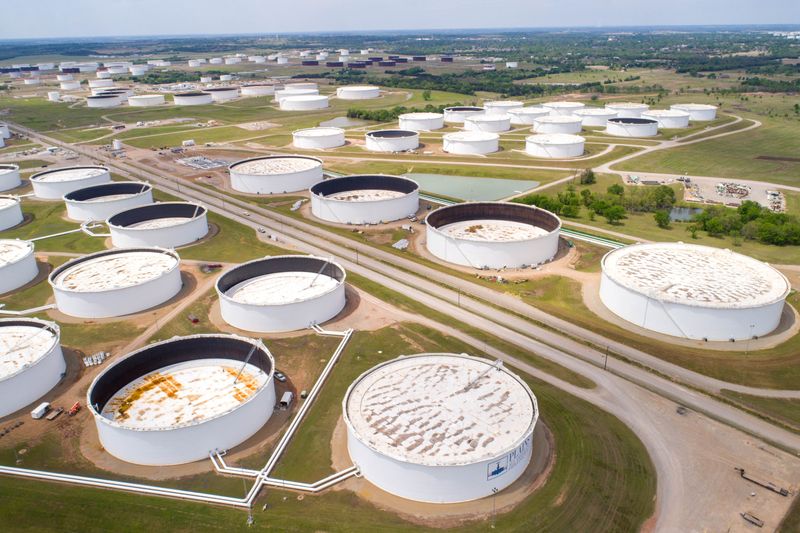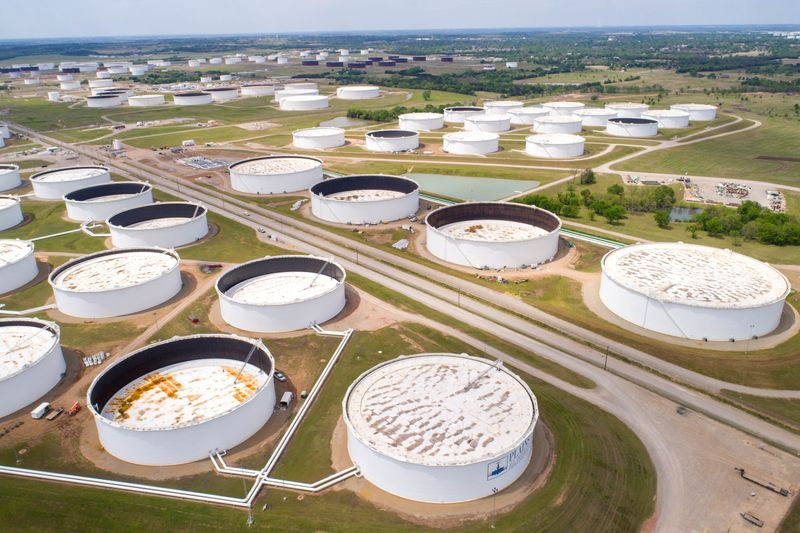Commodities
Oil surges $3 on US sanctions, tight stockpile forecasts


© Reuters. FILE PHOTO: Crude oil storage tanks are seen in an aerial photograph at the Cushing oil hub in Cushing, Oklahoma, U.S. April 21, 2020. REUTERS/Drone Base/File Photo
By Paul Carsten
LONDON (Reuters) – Oil prices leapt $3 on Friday after the U.S. tightened its sanctions programme against Russian crude exports, raising supply concerns in an already tight market, with global inventories forecast to decline through the fourth quarter.
futures rose $2.88 to $88.88 per barrel as of 1050 GMT. US West Texas Intermediate (WTI) crude gained $2.91 to $85.82 a barrel. Both benchmarks had earlier risen more than $3.
Despite fluctuations through the week in both benchmarks, Brent was set for a weekly gain of around 5%, while WTI was set to climb over 3.5% for the week, after both surged on Monday.
The uptick was driven by the potential for disruptions to Middle Eastern exports after the weekend attack by militant Islamist group Hamas on Israel threatened a wider conflict.
“(A) geopolitical risk premium still lingers around the corner that is likely to support oil prices in the short-term,” said Kelvin Wong, senior markets analyst at OANDA in Singapore.
The market was most concerned about supply constraints from the Middle East and Russia, said Wong.
But the conflict in the Middle East has so far had a restrained impact on crude prices, said Commerzbank (ETR:) analysts Thu Lan Nguyen and Carsten Fritsch in a research note.
“There has been no sign so far that the leading oil producing countries in the region will become directly involved in the military conflict, which would threaten to considerably restrict the output of these countries,” they said.
On Thursday, the U.S. imposed the first sanctions on owners of tankers carrying Russian oil priced above the G7’s price cap of $60 a barrel, to close loopholes in the mechanism designed to punish Moscow for its invasion of Ukraine.
Russia is the world’s second-largest oil producer and a major exporter and the tighter U.S. scrutiny of its shipments could curtail supply.
Also on Thursday, the Organization of the Petroleum Exporting Countries (OPEC) kept its forecast for growth in global oil demand, citing signs of a resilient world economy so far this year and expected further demand gains in China, the world’s biggest oil importer.
“Supply side issues remained the focus in the crude oil market,” Daniel Hynes, senior commodity strategist at ANZ, said in a note on Friday, adding that prices during early trade on Friday rose on the stronger U.S. sanctions enforcement.
“Sentiment was also boosted after OPEC said it expects crude stockpiles to slump by 3 (million barrels per day) this quarter. That assumes that there are no further supply disruptions emanating from the Israel-Hamas war,” Hynes said.
Oil prices also shrugged off data released on Friday showing a month-on-month decline in Chinese crude imports.
Commodities
Oil prices rise; U.S. crude inventories plunge, Russia-Ukraine truce eyed
Commodities
India’s Reliance to stop buying Venezuelan oil over US tariffs, sources say
Commodities
Oil prices climb on Venezuela supply worries

 Forex3 years ago
Forex3 years agoForex Today: the dollar is gaining strength amid gloomy sentiment at the start of the Fed’s week

 Forex3 years ago
Forex3 years agoUnbiased review of Pocket Option broker

 Forex3 years ago
Forex3 years agoDollar to pound sterling exchange rate today: Pound plummeted to its lowest since 1985

 Forex3 years ago
Forex3 years agoHow is the Australian dollar doing today?

 Cryptocurrency3 years ago
Cryptocurrency3 years agoWhat happened in the crypto market – current events today

 World3 years ago
World3 years agoWhy are modern video games an art form?

 Commodities3 years ago
Commodities3 years agoCopper continues to fall in price on expectations of lower demand in China

 Economy3 years ago
Economy3 years agoCrude oil tankers double in price due to EU anti-Russian sanctions























